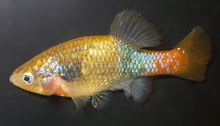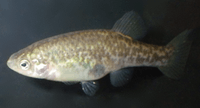Xenotoca
Xenotoca is a genus of fish in the family Goodeidae from Mexico, where found in a wide range of habitats, from rivers and creeks to pools and lakes, in the Lerma–Grande de Santiago, Panuco, Cuitzeo and other basins of the Mesa Central. While no goodeid is a very common aquarium fish, the redtail splitfin (X. eiseni), is one of the most common aquarium goodeids. Its relatively bright colors offset its reputation for being aggressive towards tankmates, occasionally even killing them.[2] Similarly to that species, two species described in 2016 have males with red-orange tails, but this feature is not shared by the remaining members of the genus.[3] The Xenotoca species are small, reaching up to 9 cm (4 in) in standard length.[4]
| Xenotoca | |
|---|---|
| Xenotoca eiseni | |
| Scientific classification | |
| Kingdom: | Animalia |
| Phylum: | Chordata |
| Class: | Actinopterygii |
| Order: | Cyprinodontiformes |
| Family: | Goodeidae |
| Subfamily: | Goodeinae |
| Genus: | Xenotoca C. L. Hubbs & C. L. Turner, 1939 |
| Type species | |
| Characodon variatus Bean, 1887[1] | |
Species


There are currently five recognized species in this genus,[3][5] but two possibly undescribed species, tentatively referred to as Xenotoca cf. melanosoma and Xenotoca cf. variata, are known.[6][7]
Genetic work has shown that the genus, as currently defined, is not monophyletic: The type species X. variata is distantly related to the remaining, which eventually will be reallocated to their own genus.[3]
- Xenotoca doadrioi Domínguez-Domínguez, Bernal-Zuñiga & Piller, 2016
- Xenotoca eiseni (Rutter, 1896) (Redtail splitfin)
- Xenotoca lyonsi Domínguez-Domínguez, Bernal-Zuñiga & Piller, 2016
- Xenotoca melanosoma Fitzsimons, 1972 (Black splitfin)
- Xenotoca variata (T. H. Bean, 1887) (Jeweled splitfin)
References
- Eschmeyer, W. N.; R. Fricke & R. van der Laan (eds.). "Xenotoca". Catalog of Fishes. California Academy of Sciences. Retrieved 22 September 2019.
- "Xenotoca eiseni". SeriouslyFish. Retrieved 16 February 2016.
- Domínguez-Domínguez, O.; Bernal-Zuñiga, D.M.; Piller, K.R. (2016). "Two new species of the genus Xenotoca Hubbs and Turner, 1939 (Teleostei, Goodeidae) from central-western Mexico". Zootaxa. 4189 (1): 81–98. doi:10.11646/zootaxa.4189.1.3. PMID 27988757.
- "Xenotoca variata". Goodeid Working Group. Retrieved 24 September 2018.
- Froese, Rainer and Pauly, Daniel, eds. (2012). Species of Xenotoca in FishBase. August 2012 version.
- ""Xenotoca" cf. melanosoma". Goodeid Working Group. Retrieved 24 September 2018.
- ""Xenotoca" cf. variata". Goodeid Working Group. Retrieved 24 September 2018.